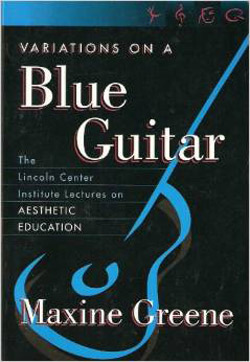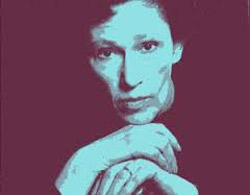Variations on a Blue Guitar: Maxine Greene on Aesthetic Education
Lectures that have inspired thousands of teachers over the past 25 years have stacked up in Maxine Greene's files.
"It felt so funny that they were all there together," said Greene who is the William F. Russell Professor in the Foundations of Education (Emerita) and Professor of Philosophy and Education (Emerita) at TC.
She copied them for her students so they wouldn't have to take as many notes. This way, they could pay full attention to what was going on in the classroom. She kept the lectures around because she felt there would be more she could learn from them.
But, thanks to her latest book, Variations on a Blue Guitar: The Lincoln Center Institute Lectures on Aesthetic Education (TC Press, 2001), everyone can learn from them. The book is peppered with literary allusions just as her everyday speech is. She uses poets like William Carlos Williams, T.S. Elliot and Elizabeth Bishop to keep the reader as engaged as her students.
Greene's new book is a collection of about 30 lectures from 1980 to the present that defines aesthetic education and explains how it can transform teachers, students, schools and communities.
"It is advertising a kind of teaching that's disappearing and being replaced with distance learning," said Greene about her book. "Teaching is a dialogue with students, but the dialogue is slowly disappearing."
Computers and new technology are creating a larger distance between students and teachers, she said. In her book, she addresses these issues of computer and aesthetic literacy.
"We want to accentuate reality and to bring persons in contact with the many ways there are or might be of being alive," she said in a 1982 lecture called, "Making the Petrified World Speak, Sing and, perhaps, Dance."
"We want, if you like," she continued, "to expand the range of literacy: offering the young new ways of symbolizing, news ways of structuring their experience, so they can see more, hear more, make more connections, embark on unfamiliar adventures into meaning."
Empowering someone to make a work of art meaningful is what aesthetic education is all about, she explained. It's about the space between the picture on the wall and you. Something happens there that's never happened in the world before because no one else is exactly like you. However, art appreciation is when you see slides, learn dates and styles, she added. It isn't really about what you see in the painting.
Aesthetic education can help bridge this gap. By no means is aesthetic education a form of art appreciation, said Greene. However, the ideal way to educate people would be to bring art appreciation and aesthetic education closer together.
Greene, who has never taken an aesthetics course in her life, said that she found her interest in aesthetics through spontaneous reactions to art such as poetry, dance, or theater. Not that she isn't qualified-Greene's love of art coupled with her knowledge of philosophy make her an expert in the field.
Greene is the founder and director of the Center for Social Imagination, the Arts and Education at the Center for Educational Outreach and Innovation. For the last 25 years, she has been philosopher-in-residence at the Lincoln Center Institute of Arts and Education. She is the subject of Markie Hancock's documentary, "Exclusions and Awakenings: The Life of Maxine Greene." She has published several books including, Landscapes of Learning, The Dialectics of Freedom, and Releasing the Imagination.
Armed with a yellow pad, she scribbles out reactions and ideas that become her lectures about five days before she gives them, she said. Agonizing over the writing, just when she thought she couldn't write about the topic, it would begin to flow. Often she wondered-and still wonders- if she was a professor or an entertainer. She found that teaching is a combination of both-the idea is to engage the class in whatever form of art she is using to explain her ideas.
"When I start to feel the students moving toward the window during a lecture, I know I am losing contact," she said with a chuckle. "So, I tell a joke or try to do anything to get them back."
Everyone engages with art differently. Greene said, "You can't tell what a difference this type of education makes-you never really know if you've done it-because you can't test for it."
Evidenced by the students still on the edge of their seats during Greene's lectures, it's obvious that she is making a difference.
Published Thursday, May. 16, 2002

